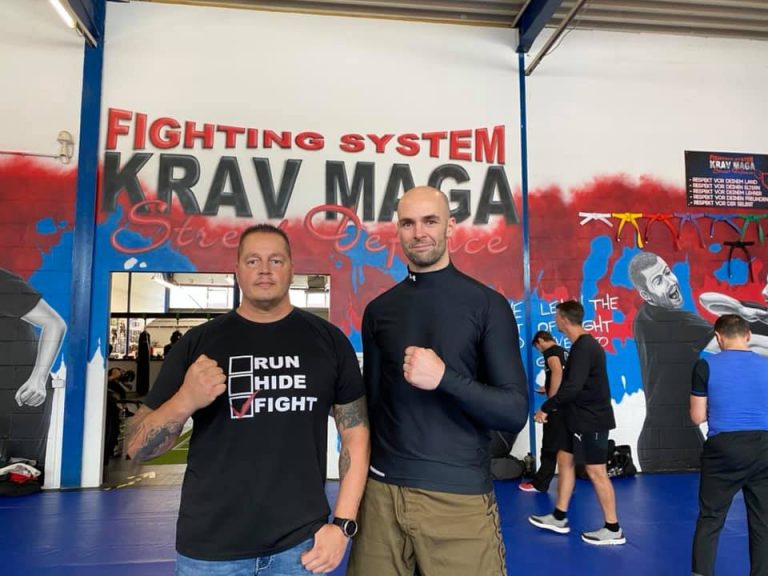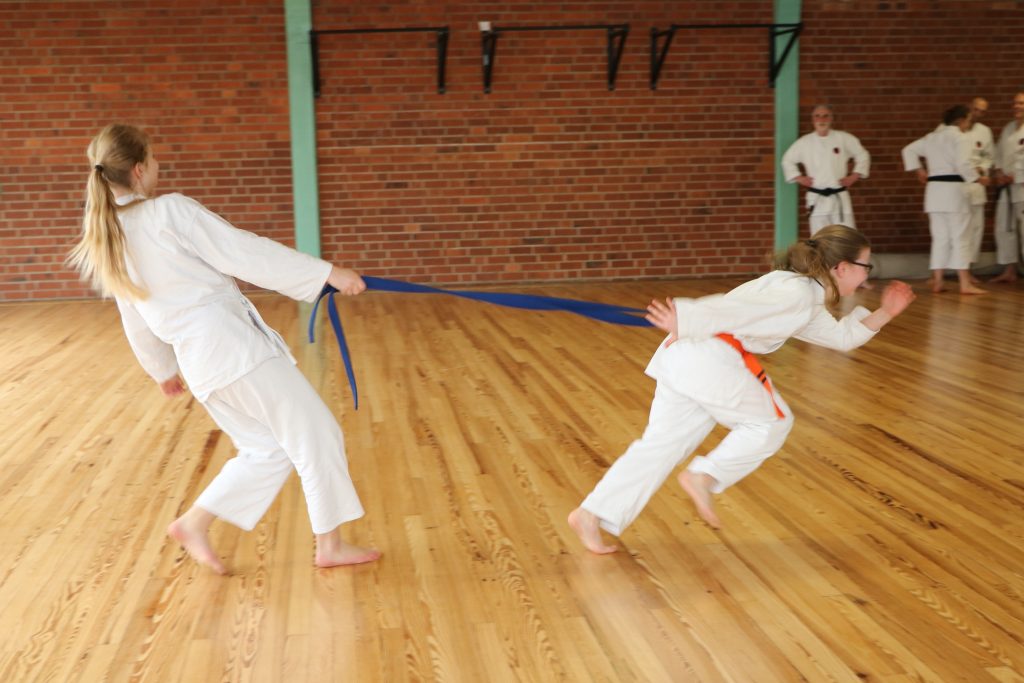Last year I shared a photo of a knife defense seminar, I participated in.
One comment was like: “… everybody knows, that running away is the only way to deal with this…“. I didn´t receive any reply on my answer to this comment, but I got aware, that some people believe in dangerous “easy solutions” and spread them without taking a closer look if they really apply to themselves or for whom they might be practical.
There are many one-size-fits-all solutions out there in the martial arts community. One example was the recent video of verbal de-escalation by a Krav Maga instructor, that made its way through social media. I totally love it, he is doing a great job there but I shared it with a certain note: it’s taken from a male perspective, for typical ´male´ situations, for certain places, where men start violence. It is not applicable to any person and any situation. It’s not a one-size-fits-all-solution.

So, what about running away when violence comes up?
Students of my dojo and the online course know my attitude: avoidance and prevention should always be the first line of defense. Avoidance, sprinting away and hiding may not be glorified in society, but they are tactically smart for the real world. Self defense is not a competition in the octagon, mostly there are no winners to identify from a combat sports perspective: you “won“, when you saved others or your own life, with the smallest amount of psychological trauma, physical injuries and and fewest legal issues possible. The closer we look at this, the more we recognize: one can never become a hero in a self-defense situation, particuarly when compared to Hollywood and the UFC (Ultimate Fighting Championships). When escaping and avoiding violent situations don´t work, we still have verbal de-escalation and verbal distance keeping as a last option. (Small example here)
Aspects of self defense and response to violent situations need to be discussed objective without emotions, I think. So, let’s take a moment and cover what I see as some of the key considerations.
- 1. What do you train mostly?
Do you train martial arts quite often, but rarely or never sprint? Then it is a pie in the sky to expect you could suddenly be more successful with the activity you train less or never, instead of the activity, you train regularly. Just imagine you are a well trained sprinter and decide to fight instead of sprinting away. What do you guess would be the outcome?
But careful, this also depends on how you train your martial art. Realistic irikumi, pressure training and many additional aspects play a cruical role on the effectiveness of your martial arts training. You can get an impression on how to apply the kata, you mostly train, when you click here. My video course offers also many suggestions for your preparation (click here). Finally it is also important to say, that there is never a 100% security, only a minimizing of risks.
„Running“ by the way is also the wrong training to get away from a violent situation. You will have to sprint and to corner sharply. Sure, adrenaline will give you a strong extra-boost, but for a successful escape, training interval sprints, sprints against resistance, hill sprints, long range sprints and other training (for example jumping, dealing with stairs and other barriers) and some climbing would be the most effective preparation.

- What is your body type ?
If you are more a heavily built person (and I belong to this group myself), you could have difficulties to start and sprint fast enough. The height of your body´s center of gravity also plays a certain role on instantly gaining speed. The closer your body shape is to that of a sprinter and the more far away your attacker´s bodyshape is away from this, the higher the chance you can escape. If you can´t escape quickly, you run the risk of being attacked from behind in a moment when you are very short in breath. A pretty bad situation.
- While you sprint away, you can´t call for help!
When you really sprint with maximum speed to save your life, you run out of gas quick and you need proper breathing. It becomes almost impossible to call for help in this situation. This aspect became even more clear to myself, when a friend shared exactly this experience with me. She went running (and was prepared for sprinting: optimal clothes, warmed up, etc.) and a potential rapist tried to get her. While sprinting away with him behind, she explained to me how it became impossible for her to scream using her breath fully for sprinting.
In cases of attempted rapes the police recommends to be loud, attrackt public attention and to resist with full force. This becomes more difficult, if a flight is not successfull and your energy is already low. Please don´t get me wrong here, I don´t recommend one of these two options. I just want you to anticipate such a situation. It´s not necessarily a clear decision and it depends on the presence or absence of other people. In terms of street harassment you can find more information here.
- Are you ready to run?
How do you visit places, where a violent incident could happen? Do you wear a backpack (this can protect your back but also hinder your sprint and balance), skirts, stilettos, or sweat pants? What kind of shoes do you wear, do you have a baby stroller with you? These facts are crucial for your decision how to invest your decreasing energy the most efficient way in critical moments.

- Are you alone?
Sprinting away and leaving your kids/parents/grandparents/less trained friends etc. behind is for many people a „no go“, I am personally one of those. As we teach our children not to enter the cars of strangers, it is an option to teach them also to stay in locked cars or run away to get help, when we are under threat or even under attack. Otherwise the damage would be multiplied. We should also have in mind to instruct adults to do the same. So sprinting away can be an option here, but not for you, if your loved ones are really loved ones.

- Are there others who need your help?
Sprinting away and calling the police can be as important as grabbing a chair and stopping an attacker from stabbing passers-by. There is only one rule: you are useless when you are dead. Disregarding your rank or belt in any martial art (belts and certificates can´t help, all you have is your experience, confidence and quality of training), you must find your role in this situation. If you think and feel, that you can´t stop a person from stabbing or attacking others, then its simply not your role in this situation; you become the person who calls the police and warns people passing by. If people get injured or die in that situation, don´t forget that the attacker is to blame, not you!
- „A knife is meant to be felt, not seen.” Doug Marcaida
In a fake martial arts bubble (and many dark or military dressed „experts“ belong into this category), we often see a scenario with a man holding a knife standing in front of someone and threatening him or her. In the real world an attacker with a serious intention to kill behaves differently, they often try to hide their weapon until its felt. And in the most of the cases you won´t even feel the stabs and cuts, a stab in your back feels more like a punch. They don´t want to see you running away. These very close distance attacks make it nearly impossible to turn and sprint away, without being harmed.
To summarize the above:
sprinting away in a dangerous situation makes sense when you…
- are good at sprinting (above average) and train it often;
- have a suitable body type;
- wear suitable clothes and don´t carry heavy backpacks/bags that you cant drop instantly;
- are alone or not leaving vulnerable people behind;
- are prepared to take the risk of being attacked from behind in a state of total exhaustion, as you try to escape;
- know your role in the situation, and you don´t forget to call help and warn others after your escape;
- have enough space to see and anticipate the attack.
To know if you are a fast sprinter, sprint for longer distances, measure the time and compare it with others. This can give you the necessary confidence to sprint away, show you a weak point to train on or encourage you to take a realistic perspective on your behaviour in critical situations. When danger arises, there is no time for long reflections, you must act instantly.
Also check your ability to deal with attacks in a defensive way and find out, if you can really handle it. For this you must know, what kind of incidents are most relevant for your body type, gender, lifestyle, the places you visit and so on. Find effective ways to deal with these threats (I would love to help you with this) and pressure test them. The closer you come to reality, the better. Intensive conditioning in between, to raise your heartrate and stresslevel, could also do their part for a simulation. For the case of multiple attackers you can find some ideas if you click here.
When you learn tested methods to minimize the damage in these situations (and there is never ever any guarantee to survive or not be injured, just slightly better chances), you begin to notice something: there are several movements developed by people, who have no clue about karate, that are very familiar for goju ryu practitioners. But this is a different story.
Thank you very much for reading my article! It still doesn´t cover everything, “freezing” for example is a critical aspect that would expand this post too far and is the topic of another article. Comments, critic and positives feedback are very appreciated as I work on constant improvement!
If you find this content helpful, please share it with your friends, dojo members and training buddies!
Very respectfully,
Thomas Meissner
